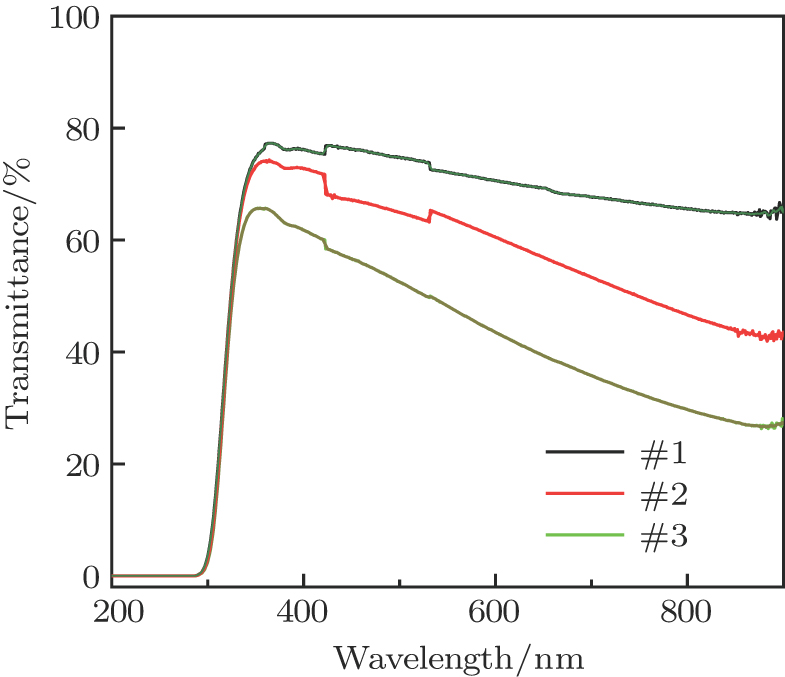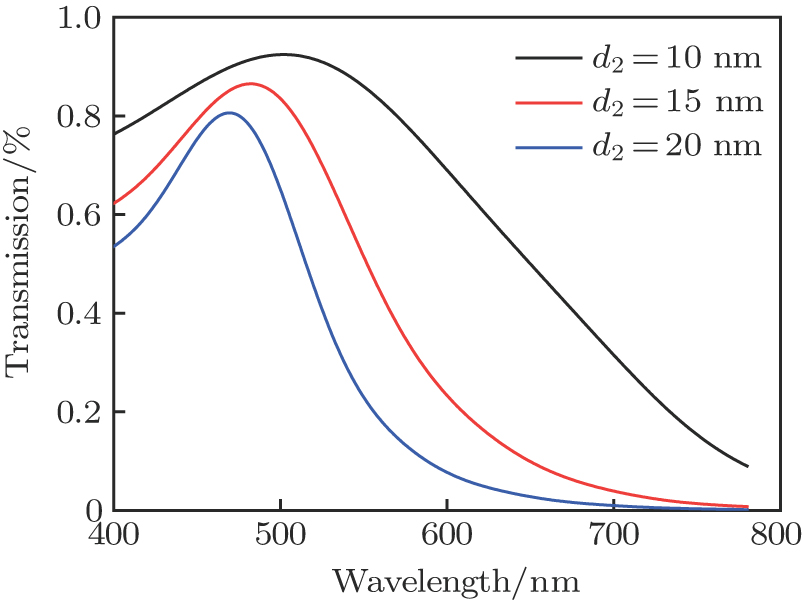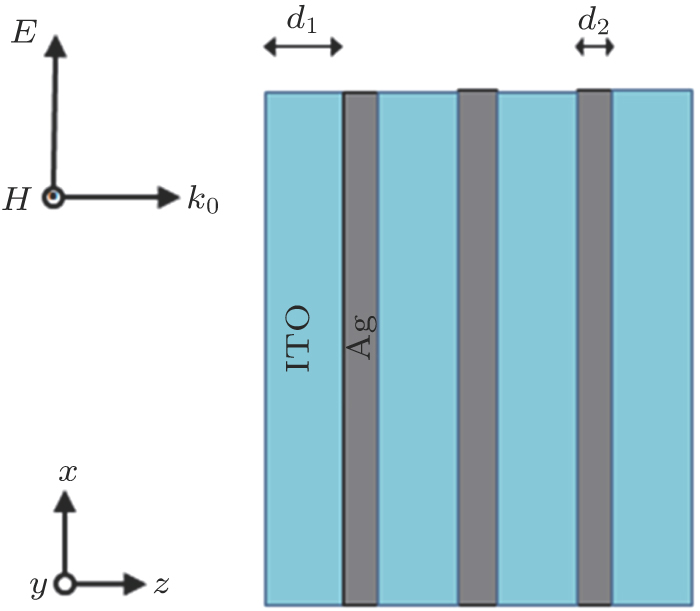† Corresponding author. E-mail:
Project supported by the International Science & Technology Cooperation Program of China (Grant No. 2014DFR10020) and the Science Foundation of Shanxi Province, China (Grant Nos. 201701D121050 and 201701D121007).
In this study, we designed and fabricated optical materials consisting of alternating ITO and Ag layers. This approach is considered to be a promising way to obtain a light-weight, ultrathin and transparent shielding medium, which not only transmits visible light but also inhibits the transmission of microwaves, despite the fact that the total thickness of the Ag film is much larger than the skin depth in the visible range and less than that in the microwave region. Theoretical results suggest that a high dielectric/metal thickness ratio can enhance the broadband and improve the transmittance in the optical range. Accordingly, the central wavelength was found to be red-shifted with increasing dielectric/metal thickness ratio. A physical mechanism behind the controlling transmission of visible light is also proposed. Meanwhile, the electromagnetic shielding effectiveness of the prepared structures was found to exceed 40 dB in the range from 0.1 GHz to 18 GHz, even reaching up to 70 dB at 0.1 GHz, which is far higher than that of a single ITO film of the same thickness.
Transparent shields (TS) have attracted great attention due to their promising applications, e.g., in personal electronic devices and the avionics aboard aircrafts and airplanes.[1,2] Such screens have been used as shields against electromagnetic interference (EMI) in the radio frequency range.[3,4] Yet it still remains difficult to achieve desirable results. For instance, metallic meshes may be bulky and heavy. In comparison, ITO films are relatively cheap and allow for a high transmittance in the visible range, but their shielding effectiveness (SE) against EMI is rather poor, which is 20 dB at 18 GHz.[5] At the same time, dielectric/metal/dielectric multilayers have also been extensively studied because they allow us to combine a high transparency with a good electrical conductivity. Such coatings have mainly been used for the fabrication of displays and solar energy control glasses.[6–8]
One-dimensional metal–dielectric photonic band gap (1D MD PBG) materials consisting of alternating metal and dielectric layers have been studied by a number of research groups.[9–14] The main characteristics of such structures are as follows: some wavelength ranges are mostly reflected, giving rise to the so-called band gaps, while other wavelength ranges are transmitted well due to the existence of pass bands.[15,16] Both the location and the width of the gap generally depend on the size of a unit, the index contrast, and the components’ thickness ratio.[17,18] It has been shown that the presence of a 1D MD PBG can enhance the total optical transmittance, and as a result, those structures have been described as “transparent metals”.[19] Meanwhile, it has been demonstrated that the total reflection can be improved by inserting metal layers into a general dielectric photonic crystal.[14–16] Furthermore, it was reported that the SE of 1D MD PBG materials can exceed 40 dB in 30-kHz range to 1000-MHz range.[20] In this paper, we report an even better SE higher than 40 dB in the range from 0.1 GHz to 18 GHz, and it is able to reach values higher than 70 dB at 0.1 GHz. We hope to reveal the regulation mechanism for adjusting the optical performance and achieving a high SE of 1D MD PBG materials. So as to distinguish the difference between monolayer Ag film and the 1D MD PBG structure, the optical properties of monolayer Ag film was measured as well.
In this work, 1D MD PBG material consists of alternating ITO and Ag layers, with the structure being periodic in the z direction and uniform in the x and y directions, as shown in Fig.
The films of ITO and Ag were sequentially deposited on glass substrates by magnetron sputtering. The system can automatically deposit 18 layers without destroying the vacuum. Prior to the deposition, the substrates were ultrasonically cleaned in acetone (CP). Then, the substrates were rinsed with deionized water (18 MΩ⋅cm) and baked at 300 °C in vacuum. The size of the substrate surface was 500 mm × 400 mm. Before sputtering, the substrates were transported from the loading chamber to the sputtering chamber via the substrate holder. Both the ITO target (10-wt.% SnO2-doped In2O3) and the Ag target (99.99% purity) had a surface area of 610 mm × 128 mm. The targets were fixed and the substrates were moved in front of the target during the sputtering process. The target-to-substrate distance was 140 mm. The ITO films were deposited at a power of 1500 W by DC magnetron sputtering and the Ag layers were sputtered at 350 W via radio frequency sputtering, respectively. During the deposition of the ITO films, the argon (99.995% purity) and oxygen (99.995% purity) flow rates were adjusted to 50 sccm and 1 sccm, respectively. In order to prevent an oxidation of the Ag films, the Ag films were deposited under argon atmosphere at a flow rate of 50 sccm. The base pressure was about 10−3 Pa and the working pressure was 0.67 Pa. The ITO and Ag growth rates were 2.5 nm/s and 2.0 nm/s, respectively. The growth rates were obtained by dividing the film thickness by the corresponding growth time, with the thickness measured using an ellipsometer (SENTECH SE8000dv-PV) and the growth time being controlled through the movement speed of the substrate holder. After fabricating the 1D MD PBG samples, the transmittance spectra of which in the UV-visible range from 300 nm to 800 nm were measured using a spectrophotometer (Shimadzu UV-310) with a resolution of 1nm. Furthermore, x-ray diffraction (XRD) measurements were carried out over the 2θ range from 10° to 70°, with a step size of 0.05° and a scanning speed of 3°⋅min−1, using a Bruker D8 x-ray diffractometer (theta-theta geometry). The surface morphology of 1D MD PBG samples was studied by scanning electron microscopy (SEM Hitachi SU3500). Accordingly, the SE was characterized utilizing the shielding chamber method with a screen size of 295 mm × 165 mm. SE of a medium is defined as follows:
The optical performance was investigated by means of finite difference time domain (FDTD) simulation.[21] For the Ag films, the frequency dispersion of which was obtained via a modified Drude model as follows:
| Table 1.
Parameters of different samples. . |
The SEM micrographs and XRD patterns obtained for the prepared 1D MD PBG structure consisting of 3.5 periods of Ag and ITO (sample #4) are shown in Fig.
Next, the optical characteristics of the Ag films and the 1D MD PBG structure were investigated. The experimentally obtained optical transmittances of the Ag films with the thicknesses of 5 nm, 14 nm, and 22 nm are presented in Fig.
 | Fig. 3. (color online) The transmission of monolayer Ag films with thickness 5 (#1), 14 (#2), and 22 nm (#3), respectively. |
The transmission was simulated by FDTD in the range from 400 nm to 800 nm for 1D MD PBG structure consisting of 3.5 periods. Keeping the thickness of the Ag films at 20 nm, the thickness of each of the ITO layers was varied from 10 nm to 100 nm and thus η was changed from 1:5 to 2:1. As shown in Fig.
To further investigate the effect of η on the optical performance of 1D MD PBG structure, the thickness of the Ag layers was varied from 10 nm to 15 nm to 20 nm, while the thickness of the ITO layers was fixed at 60 nm, again with 3.5 pairs. Here, η is equal to 1:2, 1:3, and 1:4, respectively. Compared to Fig.
 | Fig. 5. (color online) Optical transmittance spectra of 1D MD PBG as function of d2 when d1 = 60 nm. |
When comparing the experimental and simulation results obtained for sample #4, one can clearly see that the measured central wavelength is in good agreement with the theoretical results, as shown in Fig.
 | Fig. 6. (color online) Experimental and simulated optical transmittance spectra of #4 (a), and optical transmittance spectra of #4, #5, and #6 (b). |
The fixed value of Γ, however, is no longer valid when the thickness of the metal film is below a few tens of nanometers. Γ is a collision rate related to the electron mean free path l in the metal. For a metal nanostructure, the effective mean free path l1 is reduced according to the following Eq. (
In a study based on the experiment, the period of 1D MD PBG structure is 3.5 by selecting when sufficient shielding effect has been obtained.[27] In order to obtain a high SE, the influence of η on the SE was also investigated. The experimental data are shown in Fig.
Compared to single ITO films of the same thickness, which are extensively used as transparent shields, the SE can be significantly improved over a wide frequency range from 0.03 GHz to 18 GHz when using the proposed 1D MD PBG structure, as shown in Fig.
In this section, the mechanism for adjusting the optical performance will be discussed. When the thickness of each layer is sufficiently thinner than the incident wavelength, the 1D MD PBG structure can be described as homogeneous and having isotropic permittivity and permeability parameters. The whole system then could be treated as a single anisotropic medium with the permeability being equal to one and a permittivity as described below.[29,30] The permittivity of the ITO and the Ag films is defined as εd and εm, respectively, and can be calculated as follows:
 | Fig. 9. (color online) Real and imaginary parts of the effective permittivity for thickness ratios of 1:1, 1:2, 1:3, and 1:4. |
Additionally, when the incident light wave reaches 1D MD PBG structure, the energy flow vector
Generally, the angle between
According to Eq. (
This is why a smaller value of η promotes a higher optical transmission. The results generally are in good agreement with FDTD simulation results shown in Fig.
In summary, we have designed and fabricated 1D MD PBG structures with various ITO to Ag film thickness ratios. The theoretical and simulated results suggested that a high thickness ratio of the dielectric layers contributes to the enhancement of the transparency in the visible region. The transmission band will slightly shift and broaden when gradually increasing the thickness ratio of the dielectric layers. The described mechanism clearly revealed that the transmission magnitude is determined by the angle between the energy flow vector
| [1] | |
| [2] | |
| [3] | |
| [4] | |
| [5] | |
| [6] | |
| [7] | |
| [8] | |
| [9] | |
| [10] | |
| [11] | |
| [12] | |
| [13] | |
| [14] | |
| [15] | |
| [16] | |
| [17] | |
| [18] | |
| [19] | |
| [20] | |
| [21] | |
| [22] | |
| [23] | |
| [24] | |
| [25] | |
| [26] | |
| [27] | |
| [28] | |
| [29] | |
| [30] | |
| [31] |







